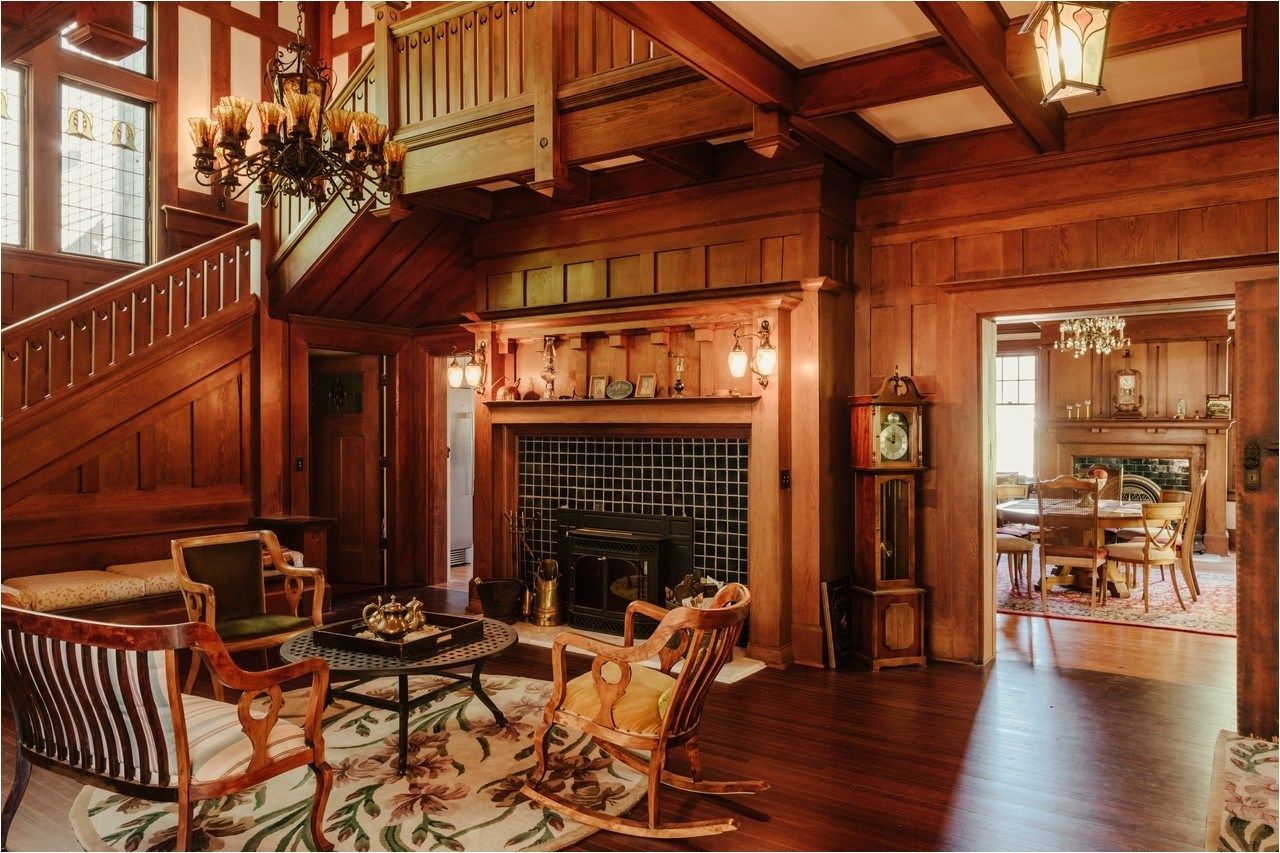If you are pursuing Tudor style houses for your ideal home, then you need to know about the history, notable features, and other important details that make Tudor homes unique. These homes transcend mere aesthetics, embodying a rich historical narrative that blends medieval grandeur with Renaissance elegance. Imagine stepping into a home that whispers tales of centuries past, a place where cozy comfort meets stately elegance. That’s the magic of a Tudor.
Decoding the Charm: Essential Tudor Elements
More than just steeply pitched roofs and decorative half-timbering, Tudors offer a unique blend of sturdy construction and romantic details, adaptable from grand mansions to cozy cottages. Picture steeply pitched roofs, often adorned with multiple gables and decorative chimney pots, reaching towards the sky like playful fingers. The prominent half-timbering—dark wood beams crisscrossing lighter stucco or brick—creates a visually striking pattern that’s instantly recognizable. Multi-paned casement windows, often featuring intricate leaded glass, add to the overall romantic feel, filtering light to create a warm, inviting ambiance. Arched doorways and grand entrances further enhance this welcoming atmosphere, beckoning you inside.
A Journey Through Time: Tudor Origins and Evolution
The story begins in 16th-century England during the Tudor dynasty’s reign. This architectural style wasn’t born overnight; it evolved, borrowing elements from medieval castles and the burgeoning Renaissance movement. From the medieval period came the sturdy construction and the tendency towards verticality. The Renaissance influence brought a touch of classical elegance, seen in decorative details and ornate embellishments. This fascinating mix of influences resulted in a style that feels both grounded and aspirational. While rooted in the past, Tudor style thrives in the present, inspiring modern adaptations that seamlessly integrate historic charm with contemporary living. Today, you’ll find “Tudor Revival” homes that retain the essential characteristics—pitched roofs, half-timbering—but incorporate modern amenities for 21st-century living.
Authenticating a Tudor: A Closer Look
Discover the secrets to identifying authentic Tudor features, from intricate brickwork and ornate chimneys to leaded glass windows and grand entryways. While the prominent features are a good starting point, it’s the details that often tell the real story. Inside, exposed beams, large fireplaces (often with elaborate mantels), and ornate woodwork suggest a genuine connection to the historical style. It’s also important to remember that Tudor architecture isn’t monolithic. Regional variations exist, likely influenced by climate and available materials. Today, we see even more diversity in modern Tudor homes, with architects exploring innovative materials and incorporating sustainable practices.
Hallmarks of Tudor Style: A Quick Guide
| Feature | Description |
|---|---|
| Roof | Steeply pitched, often with multiple gables |
| Half-Timbering | Decorative wood framing against stucco or brick |
| Windows | Multi-paned casement windows, often with leaded glass |
| Chimneys | Prominent, often multiple |
| Entryways | Arched doorways and grand entrances |
| Interior Details | Exposed beams, large fireplaces, ornate woodwork |
Unraveling the Tudor Mystique: Defining Features
So, what truly defines a Tudor? It’s more than just a look; it’s a feeling, a whisper of history. Those dramatic, sloping roofs, often punctuated by decorative chimney pots, are a statement piece. The exposed wood framing (“half-timbering”) adds character and, in original Tudors, structural integrity. The array of multi-paned casement windows brings in natural light, and the impressive arched doorways create a sense of grandeur. Inside, exposed beams and ceilings add warmth, while intricate woodwork adds elegance. Materials like brick, stone, stucco, and wood create a rich tapestry of textures.
Tudor Variations: A Spectrum of Styles
There’s more than one “flavor” of Tudor. The classic English Tudor is the blueprint. The French Tudor blends Tudor elements with French country aesthetics. The American Tudor Revival, popular in the US, is known for its brick exteriors and shingled roofs. Each offers a unique twist on the classic theme. How do you tell a Tudor from a Colonial? Tudors are typically asymmetrical with a darker color palette and signature half-timbering, while Colonials tend to be symmetrical, lighter, and more streamlined.
Debunking the “Tudor” Myth
Some architectural historians suggest that the term “Tudor” is a misnomer. The real Tudor period was relatively short, and the styles we associate with “Tudor” developed over centuries. Ongoing research continues to explore this nuanced history. So, while we use the term “Tudor,” it’s important to remember the complexities surrounding its definition.
Tudor vs. Colonial: A Style Showdown
| Feature | Tudor | Colonial |
|---|---|---|
| Symmetry | Asymmetrical | Symmetrical |
| Color Palette | Darker | Lighter |
| Half-Timbering | Prominent | Absent |
| Roof | Steeply Pitched | Moderately Pitched |
| Windows | Multi-paned Casement | Double-hung or Casement |
Identifying a Tudor is about the overall impression, the combination of elements that whisper stories of the past while offering a warm, inviting space for modern living.
Tudor Ancestry: English or German?
Tudor homes, with their blend of medieval grandeur and Renaissance flair, originated in England during the Tudor dynasty (1485-1603). While English in origin, the half-timbering technique, a prominent feature in medieval German buildings, hints at earlier German influences. This shared element sometimes sparks debate about the style’s true nationality. However, the steeply pitched roofs, majestic chimneys, charming multi-paned windows, and ornate doorways are distinctly English. While the half-timbering suggests German influence, the English adapted it, combining it with other unique details to create something new.
Tracing the Tudor Lineage
| Feature | Origin/Influence |
|---|---|
| Half-timbering | German influence, adapted and refined in English Tudor style |
| Steeply pitched roofs | English |
| Prominent chimneys | English |
| Multi-paned windows | English |
| Ornate doorways | English |
Tudor style is primarily English with a dash of German flavor. Ongoing research into architectural history might reveal further nuances. It’s a testament to how architectural ideas can travel and evolve, highlighting how different cultures can influence each other.
Tudor vs. Victorian: A Tale of Two Styles
Tudor and Victorian homes, while both historic, exude distinct architectural vibes. Tudors boast steeply pitched roofs and prominent chimneys, while Victorians feature decorative dormers, turrets, and “gingerbread” trim. Tudor walls often showcase half-timbering, while Victorian exteriors embrace various materials and vibrant colors, often with ornate details. Tudor windows are typically multi-paned, creating a quaint feel, while Victorian homes often feature large bay windows and stained glass. Inside, Tudors evoke cozy intimacy with exposed beams and fireplaces, while Victorians offer high ceilings, elaborate millwork, and a sense of grandeur.
Spotting the Difference: Tudor vs. Victorian
| Feature | Tudor | Victorian |
|---|---|---|
| Roof | Steeply pitched gable, prominent chimneys | Complex, dormers, turrets, gingerbread trim |
| Exterior | Half-timbered, stucco infill | Brick, stone, wood, ornate details, vibrant colors |
| Windows | Multi-paned, diamond/rectangular shapes | Large bay windows, stained glass |
| Interior | Exposed beams, large fireplaces, cozy | High ceilings, elaborate millwork, spacious |
| Overall Feel | Rustic, charming, intimate | Grand, ornate, opulent |
While these are common distinctions, some homes might blend elements of both styles. Ongoing research suggests that regional variations and builder preferences also played a role. This reminds us that architectural styles are constantly evolving.
- Grass Forever in Livermore: Your Guide to Artificial Turf - April 22, 2025
- German Roaches vs. American Roaches: Key Differences and Control - April 22, 2025
- 150+ Flowers That Start With S: A Comprehensive Guide - April 22, 2025










